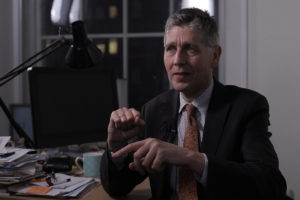Voluntary Action
Cognitive neuroscientist Patrick Haggard on the definition of voluntary action, what are the underlying mental...
The universe is expanding. The first piece of evidence that probably dates back hundreds or thousands of years: that piece of evidence is the fact that the sky is dark at night. Following that, astronomers have discovered many other pieces of evidence that, indeed, the universe is expanding, and as far as we can tell, it’s been expanding for something like 13.8 billion years. Theories by Stephen Hawking and Roger Penrose indicate that if you go back 13.8 billion years, the universe must have been very small very dense, and our laws of physics would have broken down. That breakdown of our ideas about the laws of physics is what we call the Big Bang.

So, what do we know about the history of the universe since that Big Bang? Let me start off with the fact that the sky is dark at night. Imagine that the universe was static and it had been the same throughout all of time. So, of course, if you look at the Sun, it’s very bright, it’s very hot, but if the universe was infinite and it existed for an infinite amount of time, in every direction that you could look, eventually you would see a star, and every point, every direction that you could look at in the universe would be as bright and as hot as the Sun which clearly is not the case. This was pointed out by the astronomer Olbers a couple of centuries ago, and I would regard that as being the first piece of evidence that the universe is not static.
The person who’s generally credited with discovering that the universe is expanding was the American astronomer Hubble, who, in the 1920s, was observing galaxies. What he discovered was that the light from distant galaxies varied depending on how far away those galaxies were; specifically, the light from more distant galaxies would be redder than the light from nearby galaxies. He found that this effect increased roughly linearly with distance.
So, what’s the interpretation of that? The interpretation is that when the galaxy emits the light, it’s the same, but between the time when the galaxy emits light and it reaches here, the universe expands. That means that the waves of light coming from that distant galaxy get stretched out, and the effect of stretching out the light is to make it look redder. So that’s the second piece of evidence for an expanding universe.
The third piece of evidence, which takes us far back into the early history of the universe, was the discovery in the 1960s of radiation that fills the universe in all directions. It’s not radiation that comes from stars; it’s radiation that’s almost uniform, almost isotropic: in every direction that you look, it looks very, very nearly the same. So, what’s the interpretation of this? The interpretation is that about 380,000 years after the Big Bang, the first atoms were formed. Before then, the universe would have been too hot, too dense, and too high a pressure: atoms could not be formed; they would break up as soon as you tried to make them.
But as the universe cools down and expands, atoms are formed and at the moment when those atoms are formed, they emit what you might call a birth cry. That birth cry is the radiation that we see around us in the universe today.
When that event occurred, the temperature in the universe would have been several thousand degrees Kelvin, a thousand times higher than nowadays. Nowadays, the temperature is about three degrees. So, that was the third piece of evidence for this expanding universe.
There’s another piece of evidence, which goes even further back than that: that is the measurements that we’ve made of the abundances of light elements: hydrogen, helium, lithium. We don’t think that those elements, specifically helium and lithium, could have been formed in stars. Stars make heavy elements but not helium. So, how was that helium formed? We think it was made by nuclear reactions in the early universe when it was a few minutes old. At that time, the density and the pressure in the universe would have been so high that nuclear reactions could have taken place. The same sort of nuclear reactions that are taking place today in the core of the Sun would have been taking place in the entire universe when it was a few minutes old. We can calculate in this theory what the relative amounts of those light elements should be, and it agrees very well with astronomical measurements.
So, where are we today? We have this universe that’s expanding. About twenty years ago, there was a very, very big surprise because people had expected that the expansion of the universe would gradually slow down in the same way that if you throw a stone up in the air, it slows down under the attraction of the Earth’s gravitational field. The big surprise was that the expansion of the universe was not slowing down; it was accelerating. It had slowed down for a while, but recently, in terms of the history of the universe, it had started expanding at an ever-accelerating rate. What’s the origin of that? Well, we call the origin ‘dark energy’.
Dark energy is something that is distributed throughout space. It’s not clumpy and lumpy like ordinary matter or like dark matter. It has this approximately uniform distribution throughout all the space. That’s actually not a new idea: in fact, Einstein proposed it soon after he proposed the theory of relativity. He noticed that in his equations, he could put in an additional term that came to be called ‘the cosmological constant’. ‘Dark energy’ is our modern name for basically the same phenomenon, this additional cosmological constant term in Einstein’s equations.
Amusingly, Einstein back in the day regarded a cosmological constant as being his biggest mistake but I would regard that as being one of his deepest intuitive observations that according to the general theory of relativity there could be this additional term in the equations which as we now know is causing the universe to expand faster and faster.
So what does the future hold? If nothing changes, matter in the universe will have less and less effect on its expansion as it gets older. Instead, this dark energy component will take over, and eventually, the universe will expand exponentially fast. So, how about the future of astronomy and astrophysics? It would be very dark because, with this exponential expansion, all that you could see would be stars and galaxies very close to Earth. You could not see the rest of the universe, so we actually live at a rather special time in the history of the universe where this expansion is just beginning to accelerate, but it hasn’t taken over.
A lot of people wonder why we live at this very special time when the density of dark energy is a bit more than the density of ordinary matter and dark matter, but it hasn’t really taken over yet. And what’s the origin of this dark matter? I mentioned the Higgs field, which is thought to be responsible for giving particles their mass. That actually makes a contribution to the dark energy, but it’s way too big. One of the biggest puzzles, I would say, is not why there is dark energy but why the amount of dark energy is so small.

Cognitive neuroscientist Patrick Haggard on the definition of voluntary action, what are the underlying mental...

Developmental psychologist Uta Frith on two types of attention, perception of details, and the absolute pitch

Physicist Mahdi Godazgar on the arrow of time, Schrödinger equation, and Einstein's relativity theory